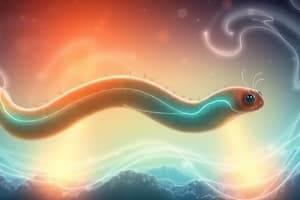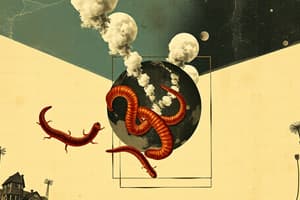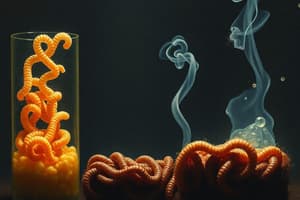Podcast
Questions and Answers
What gas do mealworms take in for respiration?
What gas do mealworms take in for respiration?
- Hydrogen
- Oxygen (correct)
- Carbon monoxide
- Nitrogen
What is released by mealworms during respiration?
What is released by mealworms during respiration?
- Nitrogen
- Carbon dioxide (correct)
- Methane
- Ozone
How does the decrease in oxygen inside the tube affect gas pressure?
How does the decrease in oxygen inside the tube affect gas pressure?
- The pressure fluctuates randomly
- The pressure decreases (correct)
- The pressure remains constant
- The pressure increases
What is the effect of the gas pressure change on the color marker?
What is the effect of the gas pressure change on the color marker?
Which gas is absorbed by soda lime during the experiment?
Which gas is absorbed by soda lime during the experiment?
In comparing inhaled and exhaled air, which of the following is NOT a typical measurement used?
In comparing inhaled and exhaled air, which of the following is NOT a typical measurement used?
What apparatus is used to collect inhaled and exhaled air?
What apparatus is used to collect inhaled and exhaled air?
Which of the following is an essential characteristic of inhaled air compared to exhaled air?
Which of the following is an essential characteristic of inhaled air compared to exhaled air?
Which type of air causes the candle flame to extinguish faster?
Which type of air causes the candle flame to extinguish faster?
What can be inferred about the oxygen content in inhaled air compared to exhaled air?
What can be inferred about the oxygen content in inhaled air compared to exhaled air?
What effect does exhaled air have on the hydrogencarbonate indicator?
What effect does exhaled air have on the hydrogencarbonate indicator?
Why does inhaled air not change the color of the hydrogencarbonate indicator?
Why does inhaled air not change the color of the hydrogencarbonate indicator?
During the experiment, what is the likely reason for shaking the jar after adding the hydrogencarbonate indicator?
During the experiment, what is the likely reason for shaking the jar after adding the hydrogencarbonate indicator?
What is the primary reason for the candle burning longer in inhaled air?
What is the primary reason for the candle burning longer in inhaled air?
What is a significant difference between inhaled and exhaled air based on the experiments conducted?
What is a significant difference between inhaled and exhaled air based on the experiments conducted?
Which property of exhaled air allows it to extinguish a candle flame more effectively?
Which property of exhaled air allows it to extinguish a candle flame more effectively?
What is the correct sequence of air pathways during inhalation?
What is the correct sequence of air pathways during inhalation?
Which of the following structures is NOT directly involved in the division of air pathways?
Which of the following structures is NOT directly involved in the division of air pathways?
In which part of the respiratory system do bronchioles end?
In which part of the respiratory system do bronchioles end?
What is the primary function of the trachea in the respiratory system?
What is the primary function of the trachea in the respiratory system?
Which statement accurately describes bronchi in the respiratory system?
Which statement accurately describes bronchi in the respiratory system?
Which structure directly follows the trachea in the airflow pathway?
Which structure directly follows the trachea in the airflow pathway?
What role do air sacs play in the respiratory system?
What role do air sacs play in the respiratory system?
What is the primary purpose of the division of bronchi into bronchioles?
What is the primary purpose of the division of bronchi into bronchioles?
What should be avoided when handling dry cobalt chloride paper?
What should be avoided when handling dry cobalt chloride paper?
Which action is necessary before applying cobalt chloride paper to the mirror?
Which action is necessary before applying cobalt chloride paper to the mirror?
What is the purpose of breathing onto the mirror during the experiment?
What is the purpose of breathing onto the mirror during the experiment?
What is the correct procedure for cleaning the mirror after the experiment?
What is the correct procedure for cleaning the mirror after the experiment?
What should be done if a student has symptoms of respiratory illness during the experiment?
What should be done if a student has symptoms of respiratory illness during the experiment?
Why is it important to record the color of the cobalt chloride paper after each step?
Why is it important to record the color of the cobalt chloride paper after each step?
What is the primary function of cobalt chloride paper in this experiment?
What is the primary function of cobalt chloride paper in this experiment?
What color change indicates the presence of moisture on cobalt chloride paper?
What color change indicates the presence of moisture on cobalt chloride paper?
What is the primary function of the pathways shown in the diagram?
What is the primary function of the pathways shown in the diagram?
During inhalation, which structure is primarily responsible for creating negative pressure in the thoracic cavity?
During inhalation, which structure is primarily responsible for creating negative pressure in the thoracic cavity?
Which of the following accurately describes the role of alveoli?
Which of the following accurately describes the role of alveoli?
What is the main difference between air flow during inhalation and exhalation?
What is the main difference between air flow during inhalation and exhalation?
Which respiratory condition primarily affects the airflow pattern during exhalation?
Which respiratory condition primarily affects the airflow pattern during exhalation?
What occurs in the respiratory system when carbon dioxide levels in the blood rise?
What occurs in the respiratory system when carbon dioxide levels in the blood rise?
Which disease is specifically mentioned as being related to smoking?
Which disease is specifically mentioned as being related to smoking?
How many people approximately die from diseases related to smoking each year globally?
How many people approximately die from diseases related to smoking each year globally?
Which statement is true regarding the air we exhale compared to the air we inhale?
Which statement is true regarding the air we exhale compared to the air we inhale?
Which of the following muscles help expand the ribs during inhalation?
Which of the following muscles help expand the ribs during inhalation?
Which of the following is NOT listed as a smoking-related disease?
Which of the following is NOT listed as a smoking-related disease?
What is a direct consequence of smoking as indicated in the content?
What is a direct consequence of smoking as indicated in the content?
Which of the following is incorrectly associated with smoking-related diseases?
Which of the following is incorrectly associated with smoking-related diseases?
Which statement regarding smoking and health is true based on the information?
Which statement regarding smoking and health is true based on the information?
What is the relationship between smoking and stroke as presented?
What is the relationship between smoking and stroke as presented?
Based on the content, which of the following is an effect of smoking on the lungs?
Based on the content, which of the following is an effect of smoking on the lungs?
Flashcards
Mealworm Respiration
Mealworm Respiration
Mealworms, like other animals, take in oxygen and release carbon dioxide during respiration.
Respiration Gas Exchange
Respiration Gas Exchange
During respiration, animals take oxygen from the air and release waste gas, carbon dioxide.
Oxygen and Respiration
Oxygen and Respiration
Oxygen is essential for respiration, a process that produces energy in living organisms, including mealworms
Carbon Dioxide and Respiration
Carbon Dioxide and Respiration
Signup and view all the flashcards
Inhaled vs. Exhaled Air
Inhaled vs. Exhaled Air
Signup and view all the flashcards
Gas Pressure Decrease
Gas Pressure Decrease
Signup and view all the flashcards
Practical 7.14
Practical 7.14
Signup and view all the flashcards
Gas Exchange in Humans
Gas Exchange in Humans
Signup and view all the flashcards
Candle flame burning time in different air types
Candle flame burning time in different air types
Signup and view all the flashcards
Inhaled air oxygen
Inhaled air oxygen
Signup and view all the flashcards
Exhaled air oxygen
Exhaled air oxygen
Signup and view all the flashcards
Carbon dioxide in exhaled air
Carbon dioxide in exhaled air
Signup and view all the flashcards
Hydrogencarbonate indicator
Hydrogencarbonate indicator
Signup and view all the flashcards
Exhaled air carbon dioxide test
Exhaled air carbon dioxide test
Signup and view all the flashcards
Inhaled air carbon dioxide test
Inhaled air carbon dioxide test
Signup and view all the flashcards
Oxygen's role in combustion
Oxygen's role in combustion
Signup and view all the flashcards
Cobalt chloride paper
Cobalt chloride paper
Signup and view all the flashcards
Dry cobalt chloride paper
Dry cobalt chloride paper
Signup and view all the flashcards
Breathing onto a mirror
Breathing onto a mirror
Signup and view all the flashcards
Cobalt chloride paper on a mirror
Cobalt chloride paper on a mirror
Signup and view all the flashcards
Color change of cobalt chloride paper
Color change of cobalt chloride paper
Signup and view all the flashcards
Why does exhaled air have more water vapor?
Why does exhaled air have more water vapor?
Signup and view all the flashcards
What happens to the cobalt chloride paper when you breathe on the mirror?
What happens to the cobalt chloride paper when you breathe on the mirror?
Signup and view all the flashcards
Why is it important to use a clean mirror?
Why is it important to use a clean mirror?
Signup and view all the flashcards
Smoking-related Deaths
Smoking-related Deaths
Signup and view all the flashcards
Respiratory Diseases
Respiratory Diseases
Signup and view all the flashcards
What is the global impact of smoking?
What is the global impact of smoking?
Signup and view all the flashcards
What are some diseases linked to smoking?
What are some diseases linked to smoking?
Signup and view all the flashcards
Lung Cancer
Lung Cancer
Signup and view all the flashcards
Bronchitis
Bronchitis
Signup and view all the flashcards
Mouth Cancer
Mouth Cancer
Signup and view all the flashcards
Stroke
Stroke
Signup and view all the flashcards
What are bronchi?
What are bronchi?
Signup and view all the flashcards
What are bronchioles?
What are bronchioles?
Signup and view all the flashcards
What are air sacs?
What are air sacs?
Signup and view all the flashcards
How does air travel in the respiratory system?
How does air travel in the respiratory system?
Signup and view all the flashcards
What is the role of capillaries in respiration?
What is the role of capillaries in respiration?
Signup and view all the flashcards
Why are air sacs important?
Why are air sacs important?
Signup and view all the flashcards
What is the relationship between bronchioles and air sacs?
What is the relationship between bronchioles and air sacs?
Signup and view all the flashcards
What is the function of the respiratory system?
What is the function of the respiratory system?
Signup and view all the flashcards
Respiration in Animals
Respiration in Animals
Signup and view all the flashcards
Air Flow During Breathing
Air Flow During Breathing
Signup and view all the flashcards
Oxygen and Carbon Dioxide Exchange
Oxygen and Carbon Dioxide Exchange
Signup and view all the flashcards
Alveoli and Gas Exchange
Alveoli and Gas Exchange
Signup and view all the flashcards
Candle Flame and Oxygen
Candle Flame and Oxygen
Signup and view all the flashcards
Testing Exhaled Air for Carbon Dioxide
Testing Exhaled Air for Carbon Dioxide
Signup and view all the flashcards
Study Notes
Gas Exchange in Animals
- Gas exchange occurs in animals as well as plants.
- Practical 7.12 aims to study the change in carbon dioxide content in animals.
Materials and Procedure (Practical 7.12)
- Materials: Boiling tubes, forceps, cotton thread, stopper, test tube rack, measuring cylinder (10 cm³), hydrogencarbonate indicator, plastic vial with small holes, mealworms.
- Procedure:
- Add 3 cm³ of hydrogencarbonate indicator to two boiling tubes (A and B).
- Record the indicator's color in each tube.
- Place mealworms in a plastic vial, then place the vial inside tube A.
- Securely stopper both tubes, ensuring no air leaks.
- Leave the setup for an hour.
- Record the indicator's color in each tube after one hour.
Practical 7.13
- Aim: To study the uptake or release of oxygen in animals.
- Materials: Boiling tubes, wire gauze, ruler, soda lime, mealworms. Capillary tubes attached to stoppers (with colour marker inside the tubes).
Discussion (Practical 7.12)
- Tube B is a control setup to ensure accurate results.
- Mealworms in tube A release carbon dioxide as indicated by the color change of the indicator (from red to yellow).
- The indicator in tube B didn't change, showing no carbon dioxide production.
Discussion (Practical 7.13)
- The results show how mealworms consume oxygen during respiration and release carbon dioxide.
Gas Exchange in Humans
- Air is inhaled and exhaled continuously.
- Inhaled and exhaled air differ in oxygen and carbon dioxide concentration.
Practical 7.14 (Comparing Inhaled and Exhaled Air)
- Aim: To compare oxygen, carbon dioxide, and water vapor content of inhaled and exhaled air.
- Materials: Gas jar with cover plates, measuring cylinder (10 cm³), mirror, dry cobalt chloride paper, stopwatch, candle, insulating mat, gas lighter, hydrogencarbonate indicator, water trough.
- Procedure:
- Cover two gas jars.
- Label the jars "inhaled air".
- Fill a gas jar with water.
- Blow into a drinking straw inserted into the other jar.
- Repeat until filled with exhaled air.
- Record the time needed for a lit candle to extinguish in each jar (inhaled/exhaled).
- Repeat the procedure, but instead of candle, add hydrogencarbonate indicator to a new gas jar.
Gas Exchange at Air Sacs
- Oxygen and carbon dioxide exchange between air in the air sacs and capillaries (blood vessels).
- Oxygen from inhaled air enters the blood, carrying oxygen to body cells.
- Carbon dioxide produced by cells is transported to the air sacs.
- The air sacs are moistened and warmed by the air.
Difference Between Inhaled and Exhaled Air
- Inhaled air has a higher oxygen content and lower carbon dioxide content than exhaled air.
- Exhaled air has a higher water vapor content and warmer temperature than inhaled air.
Effects of Smoking
- Smoking damages the respiratory system, reducing gas exchange efficiency.
- Tar deposits in the lungs, impacting the surface area of air sacs.
- Carbon monoxide reduces blood's oxygen-carrying capacity.
- Certain chemicals damage air sacs.
Harmful Effects of Smoking
- Smoking causes various diseases like lung cancer, mouth cancer, stomach cancer, bronchitis, and heart disease.
- Smokers' life expectancy is significantly shorter.
- Approximately 8 million people die annually from smoking-related diseases worldwide.
Electronic Cigarettes
- Electronic cigarettes use a battery-powered device to heat a liquid, producing a vapor that users breathe in.
- The liquid can contain nicotine, flavourings, and other chemicals that may be harmful.
Additional Information
- The lungs are protected by the rib cage and diaphragm.
- Different animals use different structures for gas exchange (e.g., gills in fish).
Studying That Suits You
Use AI to generate personalized quizzes and flashcards to suit your learning preferences.




